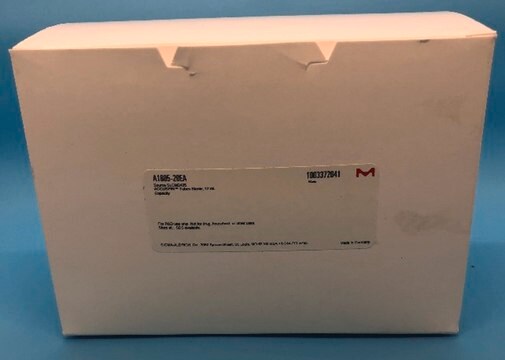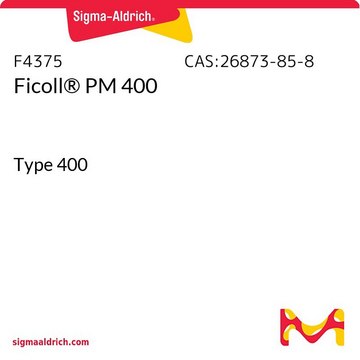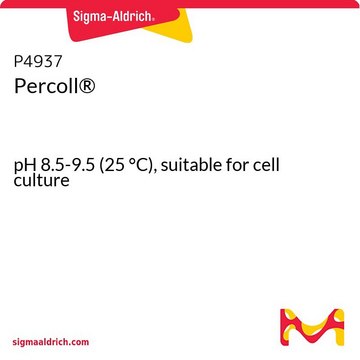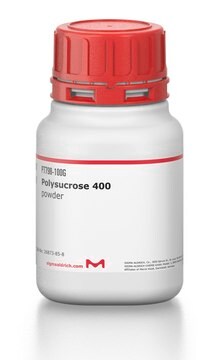11191
Histopaque®-1119
sterile-filtered, density: 1.119 g/mL
Sign Into View Organizational & Contract Pricing
All Photos(2)
About This Item
UNSPSC Code:
12352207
NACRES:
NA.75
Recommended Products
sterility
sterile-filtered
form
liquid
shelf life
Expiry date on the label.
impurities
endotoxin, tested
density
1.119 g/mL
application(s)
hematology
histology
storage temp.
2-8°C
General description
Histopaque®-1119 is a sterile, endotoxin tested, ready-to-use medium. This solution consists of polysucrose and sodium diatrizoate, adjusted to a density of 1.119 g/mL and pH 8.8–9.0.
Application
Histopaque®-1119 is suitable for use in conjunction with Histopaque-1077 as it facilitates the rapid recovery of viable mononuclear cells and granulocytes from small volumes of whole blood or bone marrow
Features and Benefits
Histopaque®-1119 offers numerous advantages, such as:
- Optimal recovery of viable cells
- Permits selective separation of blood cell types
- Prevents cell distortion
- Preserves cell viability
- Minimal extraneous cell interference
- Reproducible performance from batch to batch
- Sterile-filtered and endotoxin-tested
- Stable at 2-8°C for at least 2 years when protected from light
Principle
The process involves the formation of a double gradient on layering an equal volume of Histopaque-1077 over Histopaque-1119. Anticoagulated whole blood is carefully layered onto the upper Histopaque-1077 medium. Upon centrifugation, the erythrocytes are aggregated by polysucrose and thus rapidly sediment. Granulocytes are found at the lower Histopaque-1077/1119 interface; whereas, lymphocytes and other mononuclear cells are found at the upper plasma/Histopaque-1077 interface. Most extraneous platelets found in the upper interface are removed by low-speed centrifugation during washing steps. Erythrocyte contamination is negligible.
Legal Information
Histopaque is a registered trademark of Merck KGaA, Darmstadt, Germany
related product
Product No.
Description
Pricing
Signal Word
Warning
Hazard Statements
Precautionary Statements
Hazard Classifications
Eye Irrit. 2 - Met. Corr. 1 - Skin Irrit. 2
Storage Class Code
8A - Combustible corrosive hazardous materials
WGK
WGK 3
Flash Point(F)
Not applicable
Flash Point(C)
Not applicable
Certificates of Analysis (COA)
Search for Certificates of Analysis (COA) by entering the products Lot/Batch Number. Lot and Batch Numbers can be found on a product’s label following the words ‘Lot’ or ‘Batch’.
Already Own This Product?
Find documentation for the products that you have recently purchased in the Document Library.
Customers Also Viewed
Darin Quach et al.
Journal of bacteriology, 191(7), 2023-2032 (2008-12-31)
Group B Streptococcus (GBS) is major cause of invasive disease in newborn infants and the leading cause of neonatal meningitis. To gain access to the central nervous system (CNS), GBS must not only subvert host defenses in the bloodstream but
Atsushi Masuda et al.
Nutrients, 11(5) (2019-05-15)
Long-term exposure to a high starch, low-protein diet (HSTD) induces body weight gain and hyperinsulinemia concomitantly with an increase in β-cell mass (BCM) and pancreatic islets number in mice; however, the effect of short-term exposure to HSTD on BCM and
Ulrich Flögel et al.
Circulation, 118(2), 140-148 (2008-06-25)
In this study, we developed and validated a new approach for in vivo visualization of inflammatory processes by magnetic resonance imaging using biochemically inert nanoemulsions of perfluorocarbons (PFCs). Local inflammation was provoked in 2 separate murine models of acute cardiac
Yuan Li et al.
BMC genomics, 16, 369-369 (2015-05-10)
Understanding genetic determinants of a microbial phenotype generally involves creating and comparing isogenic strains differing at the locus of interest, but the naturally existing genomic and phenotypic diversity of microbial populations has rarely been exploited. Here we report use of
Michael Molitor et al.
Cardiovascular research, 117(1), 162-177 (2020-02-23)
Heart failure (HF) ensuing myocardial infarction (MI) is characterized by the initiation of a systemic inflammatory response. We aimed to elucidate the impact of myelomonocytic cells and their activation by angiotensin II on vascular endothelial function in a mouse model
Our team of scientists has experience in all areas of research including Life Science, Material Science, Chemical Synthesis, Chromatography, Analytical and many others.
Contact Technical Service










